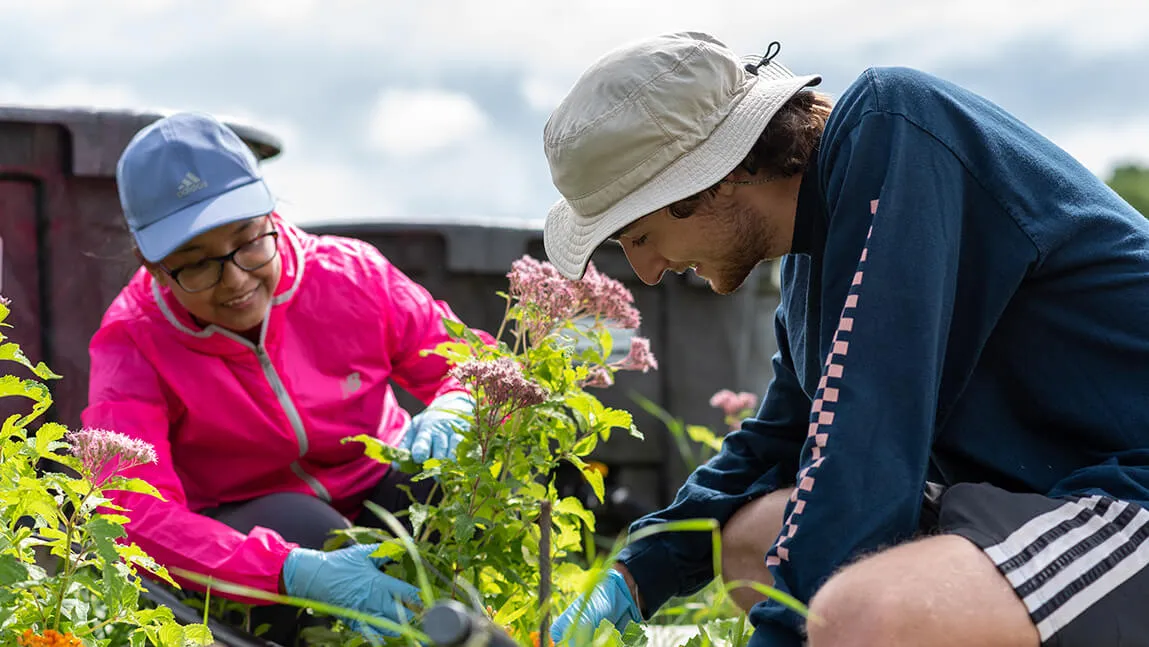Senior Bryce Carleton ’22 wasn’t really sure what he wanted to do when he entered college. A class at his Exeter, New Hampshire high school on wind turbines and the idea of green roofs intrigued him, and he liked plants. He chose the Environmental Sciences major in the University of Vermont (UVM) Rubenstein School of Environment and Natural Resources, which gave him the flexibility to expand upon his interests in many ways, and he ran with it.
“I like the idea of pairing technology and the natural environment to better human lives,” said Bryce, who chose to concentrate in Ecological Design.
For an assignment in a first-year Rubenstein School course, he wrote about his fascination with green roofs. Instructor Gary Hawley, Bryce’s first-year advisor, encouraged Bryce to take the Greening of Rubenstein Interns course, in which students work with faculty and staff to advance energy efficiency and sustainability of the School, its buildings, and the campus. Local experts and consultants share their expertise with the interns as they develop and complete their semester projects.
Bryce took the course his sophomore year and became part of a long legacy of undergraduate contributions to sustainability at UVM. He built a portfolio of ecological design experiences—hands-on courses, an internship, teaching, and research—that led to a job in his field upon graduation.
“The rest,” said Bryce, “is history.”
Experiential learning in courses as intern, designer, teacher
In the Greening course taught by Gary, Bryce joined a group of interns serving as caretakers for the glass solarium on the south side of the Aiken Center, the School’s main building on campus. The Aiken Solarium provides a warm, welcoming entrance. Stonewalls and beds of plants form attractive study and casual meeting areas. Bryce developed expertise in caring for the plants and introduced creative, sustainable ways to make the space more useful and inviting.
"This course gives students the unique and beneficial opportunity to gain experience and insight into the professional world awaiting them after graduating,” said Bryce, who began his career during senior year with a past class partner and returning guest speaker. “I saw myself and the many other students over the years grow from the work involved, and I will always be thankful for Gary Hawley and his Greening of Rubenstein course.”
His success as an intern in the course and his passion for plants blossomed into two years as a teaching assistant and mentor to students in the Solarium group. Bryce played a large role in replanting and revitalizing the space following a year of remote learning and absence of staff on campus during COVID-19.
Bryce also delved into hands-on ecological design courses taught by Rubenstein School Associate Professor Eric Roy, who guides students in using technology and ecological principles to design and build systems that mimic natural processes to treat water and grow plants and food. Bryce created a mobile chamber to grow mushrooms that is now on display in the Solarium.
“Eric made us think in different ways,” said Bryce. “He allowed us a lot of freedom to build what we wanted, and he encouraged us to use our imaginations backed by science.”
Research experience in grant writing, fieldwork, data collection, presenting
Through Eric, Bryce met Associate Professor Stephanie Hurley, a landscape and ecological design expert in the College of Agriculture and Life Sciences. He jumped on the chance to collaborate with her to write a grant proposal, which resulted in a UVM Gund Institute for Environment Undergraduate Research Award in August 2021.
With his grant, during his senior year, he worked with Stephanie and her postdoctoral associate and graduate student to study biorention systems, high-tech rain gardens that catch, slow, and filter stormwater runoff from rooftops, roadways, and other human-made impervious surfaces. Using 12 tanks at the UVM Horticulture Research and Education Center, Bryce assessed how well different soil compositions and native plants can be used to treat polluted stormwater runoff. The research will inform the design of future green stormwater infrastructure best management practices in Vermont to help clean water flowing to downstream ecosystems.
He presented his project, “Exploring Bioretention Soil Media Efficacy for Native Plant Establishment with Minimal Nutrient Leaching,” at the UVM Student Research Conference in April 2022. Bryce shared his grant writing and research experience as a presenter at UVM’s Office of Fellowships, Opportunities and Undergraduate Research FIRE (Fall Intro to Research) to help other undergraduates get started in research on campus.
Experiences grow into job opportunity
With his ecological design experiences in research, teaching, and design and building, Bryce dove into a job his senior year. The Greening of Rubenstein Interns course partner and guest speaker introduced Bryce to Resource Innovation Institute, a nonprofit start-up, headquartered in Portland, Oregon, that works to advance energy, water, and resource efficiency and sustainability in the controlled environment agriculture industry. Before graduation, he interviewed and was hired to begin working part-time with the institute as a resource efficiency engineer.
After graduation, Bryce returned to his hometown of Exeter to work remotely for Resource Innovation Institute as a full-time engineer and get boots-on-the-ground experience in the field while helping farmers and growers improve their production and environmental performance.
